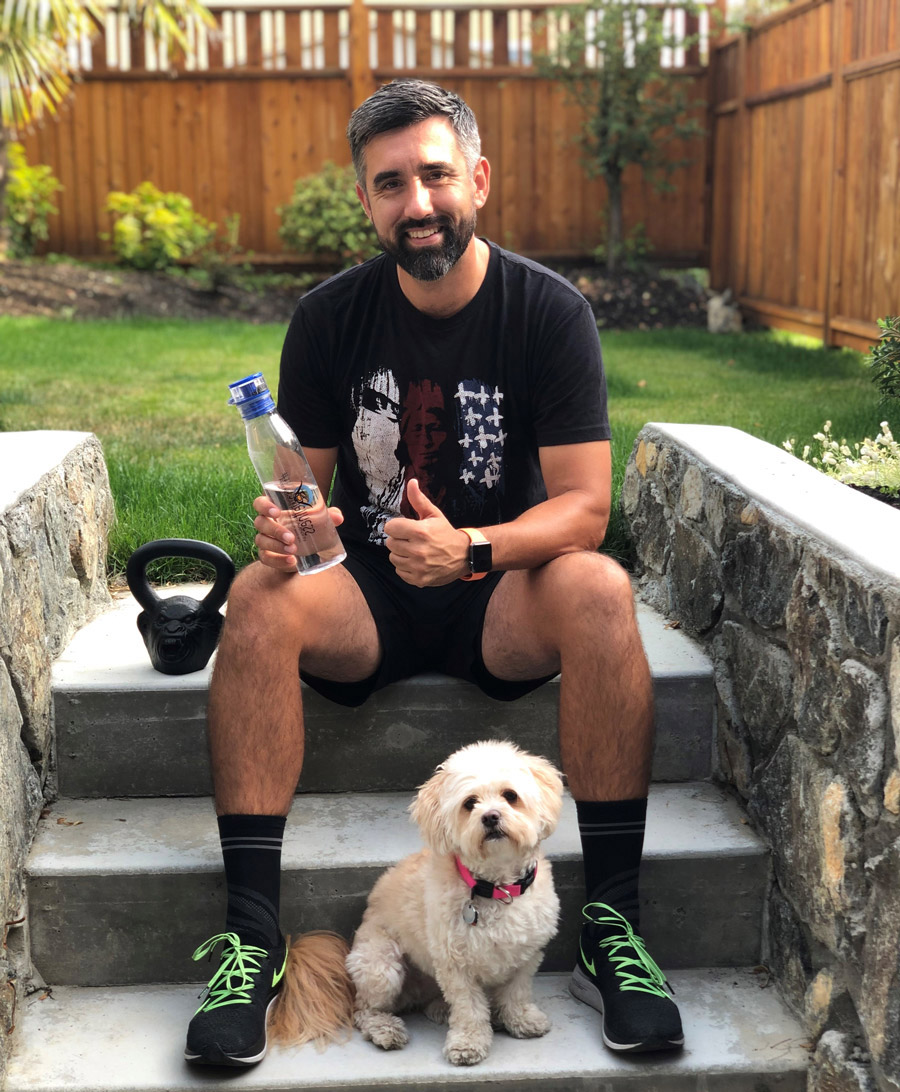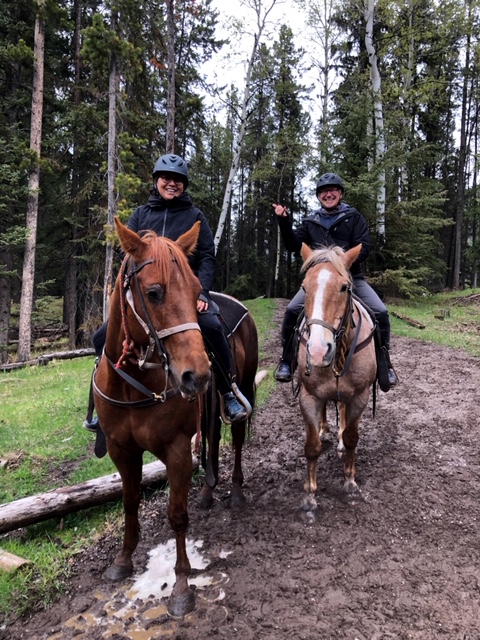The FNHA is sponsoring a 30x30 Active Challenge - an invitation to commit to the goal of doing 30 minutes of physical activity for each of the 30 days of September. FNHA Doctors Kelsey Louie and Nel Wieman have the following advice for getting started, staying motivated and keeping safe.

Dr. Kelsey Louie stays active with the help of Olive the wonder dog!

Dr. Nel Wieman and her partner Gary love to go horseback riding wherever they travel. This photo was taken in Banff in May of this year. Nel and Gary have also been horseback riding in Melbourne, Australia; Reykjavik, Iceland; and Palm Springs. This week their vacation in Newfoundland will include a two-day riding adventure in Gros Morne National Park. "I think the key to being active is to mix things up!" says Dr. Nel who – along with Gary – is also an advanced open-water scuba diver.
If you are one of the 1,500-plus people who have currently signed up for our 30x30 Active Challenge – congratulations! We've both signed up too!
If you've already signed up, we're here to help you to get off to a good start by discussing some tips for staying motivated. If you haven't signed up – yet! – we want to encourage you to participate by describing achievable strategies for anybody – and any body! It's also useful to remember why it's so helpful to be active on a regular basis.
Know the Benefits of Regular Physical Activity
• Improved energy
• Better sleep
• Stronger social connections/decreased isolation (if you're active with others)
• Improved mood and overall psychological wellness
• Improvements in physical wellbeing, including the prevention or delay of chronic health conditions
• Support to achieve or maintain a healthy weight
• More brain power (learn more about your brain on exercise!)
There are many benefits to being physically active and these benefits are well known. Why then, do so many of us find it difficult to become or remain active on a regular basis?
We believe it is important to identify and understand barriers to physical activity so we can create strategies to overcome them. Some of the common barriers we've heard in our medical practices include the following:
Physical and Logistical
• Chronic conditions like low back pain, diabetes, heart disease, etc.
• Accessibility of safe spaces - e.g., walking paths, well-lit roads, or risks from wildlife, such as bears or cougars!
• Pollution (e.g., smoke from wildfires)
• Fear of being injured or re-injured
• Practical factors such as child care or transportation to recreation facilities
• Cost concerns – "I need to join a fancy gym or buy an expensive piece of exercise equipment!"
Emotional
• Chronic depression or PTSD (post-traumatic stress disorder), which can create symptoms such as low energy, low levels of motivation, or an inability to leave your home due to anxiety
• Stress – e.g., a busy daily routine that leaves you feeling over-scheduled with no time to exercise
• Low self-esteem – consciously or not, some people wonder if it's worth investing in their own wellbeing, even if that investment is a modest amount of time and effort
You Can Do It!
The good news is: there are ways to work around each of these obstacles! Here are some tips to consider:
• "Start low, go slow." We advise people who have been inactive and who are starting this challenge to go easy at first. This will reduce the risk of injury and help you maintain your motivation because a modest goal is an achievable goal.
• Speaking of starting slow(ly): break the 30 minutes of daily activity into smaller amounts, e.g., three 10-minute periods. This is just as effective as one 30-minute session (some studies say it can even be more beneficial!)
• "Make your day harder." This idea refers to building physical activity into your daily routine. For example: take the stairs instead of the escalator or elevator; if you are driving somewhere, park further away so you walk the last five to 10 minutes; use your grocery bags as "weights." Find more tips to make your day harder on the website of the Reframe Health Lab (founder Dr. Mike Evans went to medical school with Dr. Nel at McMaster University!) Look under the "Health Picks" tab and then click on "Everyday Health & Wellness" and then "Activity & Exercise".
• Do activities with others. Not only does this increase connectedness but it often helps with accountability and motivation. What's more, if you are active with your children or grandchildren, you are setting a great example that will encourage them to adopt healthy habits throughout their lives.
• Consider what works for you. For example, outdoor spaces can be great to connect with traditional lands and nature but for some people – such as those with asthma, mobility issues, or wildlife safety concerns – an indoor facility like a recreation gym or even a local mall might be a good option. Some malls even have free activity programs, such as stroller walking for new parents, or mall walking times for seniors.
• Consider what you enjoy – or think you may enjoy. If your activity isn't fun, it's going to be tough to keep going! Remember, too, that activities like gardening, picking berries, dancing, walking the dog or playing tag with your kids all count! You don't have to go to a class, work out at a gym, or belong to a team to find a physical activity that you enjoy and that supports your well-being.
• Try new activities. Keeping your physical activity "fresh" helps keep you motivated. Have you heard of Pickleball? Bellyfit? DrumFit? These are just a few new activities that have gained popularity in recent years. Maybe your new favourite activity is one you haven't heard of yet! Moreover, our bodies change over time. You may need to find a new activity that isn't as hard on your body as soccer, boot camp class, or running!
• Stay safe. If there are concerns about your physical health status – whether through injury or a medical condition – we encourage you to check with a healthcare provider (e.g., a physician, community nurse, or physiotherapist) to review your situation.
• "Listen" to your body. If you have aches and pains during or following activity, consider that you may be doing too much, too quickly. Take the time to recover in a good way. "Sometimes sore muscles feel good after a soak in the river or ocean, or a cold bath – an old soccer trick I learned back in the day," says Dr. Kelsey. Dr. Nel says: "Cold bath?! How about a relaxing soak in a warm bath with Epsom salts?" Fortunately, both are good strategies!
Get Inspired!
Finally, we remind you to look for inspiration in the successes of others. Take the story of Arthur, an Indigenous Canadian veteran who was suffering from physical pain and limited mobility to the point where he was told he would never walk again. He felt that everyone had given up on him. However, one yoga instructor believed in him and helped Arthur start a journey to wellness. We hope you watch this video and feel inspired!
Arthur's Story
https://www.youtube.com/watch?v=qX9FSZJu448
Join the Challenge
Sign up online now at: https://fnha.wishpondpages.com/30x30-active-challenge/. We're even offering prizes! The next 30x30 Active Challenge prize draw (a $150 Sport Chek gift card) takes place Aug. 30. To qualify, you have to register for the challenge and "Like" and "Share" our Facebook post.
We'd also love to hear your 30x30 stories. Post on social media using the hashtags #FNHAWellness; #30x30ActiveChallengeFNHA or #BeActiveFNHA or tag the FNHA social media accounts.

